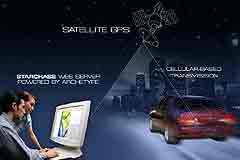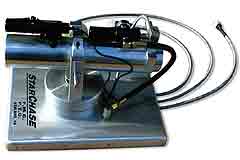I live here in Southern California where hardly a week goes without a car chase appearing on TV. While popular with viewers , they often boost a station’s ratings, they are very dangerous. Many end in a crash often injuring bystanders or, unfortunately, cause a fatality. A company in Virginia Beach, VA has developed a promising alternative to hot pursuits, the StarChaseâ„¢ Pursuit Management System. The StarChase system is now being field tested by the Los Angeles Police Department.

Here, an electronic tracking tag is fired at the vehicle and it adheres to the vehicle. The tag contains a miniature, rugged GPS receiver; radio transmitter; and power supply. These off-the-shelf items are embedded in a specially developed adhesive compound. The tag is fired at the suspect vehicle from a compressed air launcher. The launcher can be installed on the police car or handheld by an officer.
The tag activates as soon at it attaches to the vehicle. Then it continually transmit’s the vehicle’s exact position every few seconds via wireless modem to the StarChase secure server. The server in turn makes the position of the vehicle and its movement available to authorized users via a password-protected Web site. The vehicle location and movement is shown on a map display on a computer.

The StarChase “bread-trail” data provides historical evidence for any pursuit or interdiction event. The system uses a National Security Agency (NSA) approved, patent-pending data-transmission encryption technique to ensure security at all levels. The built-in log of court-admissible data plus the extensive levels of encryption and security ensure that the chain of evidence is preserved. The secure Web portal, for example, the dispatcher can send commands to control vehicle location functions, such as geo-fence alerts, update status, module health checks, or changing update rates to preserve battery life.
The StarChase uses a technique called assisted GPS (AGPS). Here signals from a wireless server, usually a cellular carrier, help the receiver locate and compute the orbits of the GPS satellites. This greatly speeds up the initialization process so the first fix is available almost immediately. AGPS also provides superior performance and greater accuracy especially in such locations as “urban canyons” where the GPS satellite signals are very weak or affected by multipath effects. The delay time between the transmission and the refreshed picture at the Web site is about 2-3 seconds.




